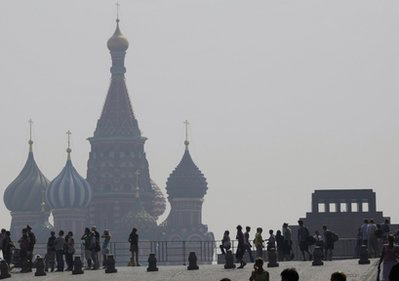|
 In this July 29, 2010 file photo, Moscow's St. Bazil's Cathedral, background, is seen through a smog covering Moscow during a heat wave. The mausoleum of Vladimir Lenin is at right. The excessive amount of extreme weather that dominated 2010 is a classic sign of man-made global warming that climate scientists have long warned about. They calculate that the killer Russian heat wave, setting a national record of 111F (nearly 44 C), would happen once every 100,000 years without global warming. |
|
This was the year the Earth struck back. Earthquakes, heat waves, floods, volcanoes, super typhoons, blizzards, landslides and droughts killed at least a quarter million people in 2010 — the deadliest year in more than a generation. More people were killed worldwide by natural disasters this year than have been killed in terrorism attacks in the past 40 years combined. "It just seemed like it was back-to-back and it came in waves," said Craig Fugate, who heads the US Federal Emergency Management Agency. It handled a record number of disasters in 2010. "The term ‘100-year event’ really lost its meaning this year." And we have ourselves to blame most of the time, scientists and disaster experts say. Even though many catastrophes have the ring of random chance, the hand of man made this a particularly deadly, costly, extreme and weird year for everything from wild weather to earthquakes. Poor construction and development practices conspire to make earthquakes more deadly than they need be. More people live in poverty in vulnerable buildings in crowded cities. That means that when the ground shakes, the river breaches, or the tropical cyclone hits, more people die. The January earthquake that killed well more than 220,000 people in Haiti is a perfect example. Port-au-Prince has nearly three times as many people — many of them living in poverty — and more poorly built shanties than it did 25 years ago. So had the same quake hit in 1985 instead of 2010, total deaths would have probably been in the 80,000 range, said Richard Olson, director of disaster risk reduction at Florida International University. Climate scientists say Earth's climate also is changing thanks to man-made global warming, bringing extreme weather, such as heat waves and flooding. The excessive amount of extreme weather that dominated 2010 is a classic sign of man-made global warming that climate scientists have long warned about. They calculate that the killer Russian heat wave — setting a national record of 111 degrees — would happen once every 100,000 years without global warming. Preliminary data show that 18 countries broke their records for the hottest day ever. White House science adviser John Holdren said we should get used to climate disasters or do something about global warming: "The science is clear that we can expect more and more of these kinds of damaging events unless and until society's emissions of heat-trapping gases and particles are sharply reduced." (Read by Nelly Min. Nelly Min is a journalist at the China Daily Website.) (Agencies) |
今年,地球开始反击了。 2010年死于地震、热浪、洪灾、火山喷发、超强台风、暴风雪、山体滑坡和干旱的人数超过了25万人,是30多年来死亡人数最多的一年。全球死于自然灾难的人数超过过去40年来死于恐怖主义袭击的人数的总和。 美国联邦紧急事务管理局局长克雷格•富盖特说:“(灾难)像海浪般接踵而至。” 2010年该局处理的灾难数目突破了历史记录。 “在这种情况下,‘百年一遇’一词也失去了意义”,尤盖特说。 科学家和灾难专家们认为大部分灾难都是人类自己造成的。 尽管很多灾难看起来是偶发事件,但是人类的行为使得今年的自然灾害(从恶劣的天气到毁灭性的地震)造成的后果尤其严重。今年是死亡人数飙升、损失惨重、天气极端异常的一年。 低劣的建筑质量和开发行为加大了地震的杀伤力。越来越多的人挤在城市的危房里,过着贫苦的生活。这意味着,一旦地震发生、河堤决口、或者热浪来袭,会有更多的人死亡。 一月份发生的造成22万多人死亡的海地地震就是一个典型的例子。跟25年前相比,海地首都太子港市的人数增加了两倍,很多人生活贫困,城市中到处都是简陋的棚户区。“如果同样的地震发生在1985年,那么死亡人数应该在8万左右”,弗罗里达国际大学减灾办公室主任理查德•奥尔森说。 气象科学家说地球的气候也在发生变化。人为造成的全球变暖带来了极端的天气,使得热浪肆虐,洪水泛滥。 2010年过度频繁的极端天气是人为全球变暖的一个显著表现。气象科学家们一直都在警告人们注意全球变暖,他们推算说如果没有全球变暖的话,那么今年在俄罗斯发生的破纪录的111度(华氏)高温天气每10万年才会发生一次。 之前的数据显示,今年有18个国家的最高气温打破了历史纪录。 白宫科学顾问约翰•霍德伦认为,我们应该采取行动应对全球变暖,不然就得适应气候灾难。“道理很清楚,如果我们不能大量减少吸热气体和微粒的排放,那么这种极具破坏力的灾难会越来越多。” 相关阅读 (中国日报网英语点津 崔旭燕 编辑:陈丹妮) |
|
Vocabulary: a generation: 一代通常认为大约30年 back-to-back: 接连地;接二连三地 have the ring of: 听起来,看起来 cyclone: a violent tropical storm in which strong winds move in a circle(气旋;旋风) |
